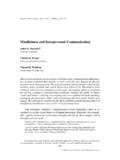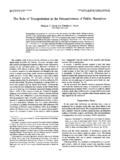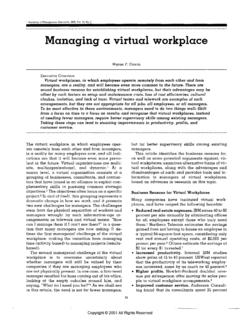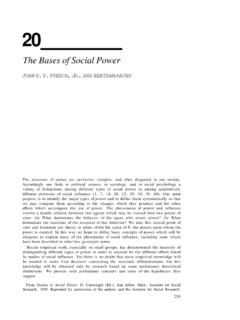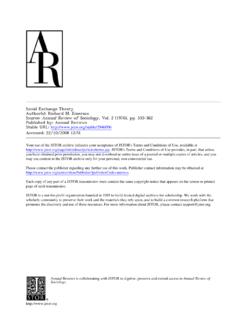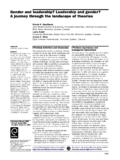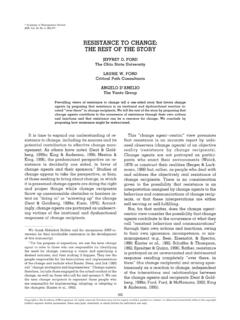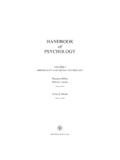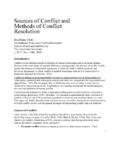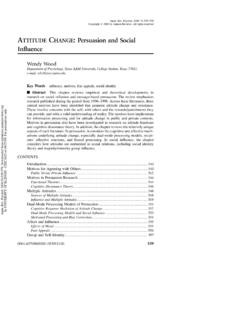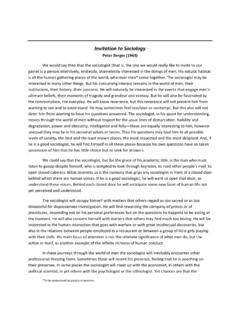Transcription of CHAPTER 10 UNCERTAINTY REDUCTION THEORY
1 94 CHAPTER 10 UNCERTAINTY REDUCTION THEORY Outline I. Introduction. A. Charles Berger notes that the beginnings of personal relationships are fraught with uncertainties. B. UNCERTAINTY REDUCTION THEORY focuses on how human communication is used to gain knowledge and create understanding. C. Any of three prior conditions anticipation of future interaction, incentive value, or deviance can boost our drive to reduce UNCERTAINTY . II. UNCERTAINTY REDUCTION : to predict and explain. A. Berger's focus on prediction echoes Shannon and Weaver. B. His emphasis on explanation (our inferences about why people do what they do) comes from Fritz Heider. C. There are two types of UNCERTAINTY . 1. Behavioral questions, which are often reduced by following accepted procedural protocols.
2 2. Cognitive questions, which are reduced by acquiring information. III. An axiomatic THEORY : certainty about UNCERTAINTY . A. Berger proposes a series of axioms to explain the connection between UNCERTAINTY and eight key variables. B. Axiom 1, verbal communication: as the amount of verbal communication between strangers increases, the level of UNCERTAINTY decreases, and, as a result, verbal communication increases. C. Axiom 2, nonverbal warmth: as nonverbal affiliative expressiveness increases, UNCERTAINTY levels will decrease. Decreases in UNCERTAINTY level will cause increases in nonverbal affiliative expressiveness. D. Axiom 3, information seeking: high levels of UNCERTAINTY cause increases in information-seeking behavior.
3 As UNCERTAINTY levels decline, information-seeking behavior decreases. E. Axiom 4, self-disclosure: high levels of UNCERTAINTY in a relationship cause decreases in the intimacy level of communication content. Low levels of UNCERTAINTY produce high levels of intimacy. F. Axiom 5, reciprocity: high levels of UNCERTAINTY produce high rates of reciprocity. Low levels of UNCERTAINTY produce low levels of reciprocity. G. Axiom 6, similarity: similarities between persons reduce UNCERTAINTY , while dissimilarities produce increases in UNCERTAINTY . H. Axiom 7, liking: increases in UNCERTAINTY level produce decreases in liking; decreases in UNCERTAINTY produce increases in liking. I. Axiom 8, shared networks: shared communication networks reduce UNCERTAINTY , while a lack of shared networks increases UNCERTAINTY .
4 95 IV. Theorems: the logical force of UNCERTAINTY axioms. A. Through pairing axioms, Berger creates 28 theorems. B. These 28 theorems suggest a comprehensive THEORY of interpersonal development based on the importance of reducing UNCERTAINTY in human interaction. V. Strategies to cope with certain UNCERTAINTY . A. Most social interaction is goal-driven; we construct cognitive plans to guide our social interaction. 1. Berger claims plans are hierarchically organized with abstract representations at the top of the hierarchy and progressively more concrete representation toward the bottom. 2. Switching strategies at the top of the hierarchy causes changes down the hierarchy, altering behavior. B. UNCERTAINTY is central to all social interaction. C. There is an interaction between UNCERTAINTY REDUCTION THEORY and plan-based message production that suggests various strategies individuals use to cope with UNCERTAINTY and hedge against risk when deploying messages.
5 1. Seeking information through a passive, active, or interactive strategy. 2. Choosing plan complexity the level of detail a plan includes and the number of contingency plans. 3. Hedging planning ways for both parties to save face when at least one of them miscalculated. 4. The hierarchy hypothesis: when individuals are thwarted in their attempts to achieve goals, their first tendency is to alter lower-level elements of their message. VI. Critique: nagging doubts UNCERTAINTY . A. As Berger himself admits, his original statement contained some propositions of dubious validity. 1. Critics such as Kathy Kellermann consider theorem 17 particularly flawed. 2. The tight logical structure of the THEORY doesn't allow us to reject one theorem without questioning the axioms behind it.
6 3. In the case of theorem 17, axioms 3 and 7 must also be suspect. 4. Kellermann and Rodney Reynolds challenge the motivational assumption of axiom 3. 5. They also have undermined the claim that motivation to search for information is increased by anticipation of future interaction, incentive value, and deviance. B. Michael Sunnafrank challenges Berger s claim that UNCERTAINTY REDUCTION is the key to understanding early encounters. 1. He believes that predicted outcome value more accurately explains communication in early encounters. 2. Berger insists that you can't predict outcome values until you reduce UNCERTAINTY . C. Despite these problems, Berger's THEORY has stimulated considerable discussion within the discipline. 96 Key Names and Terms Charles Berger A communication theorist at the University of California, Davis, who developed UNCERTAINTY REDUCTION THEORY .
7 Fritz Heider As the founder of attribution THEORY , this psychologist argued that we constantly draw inferences about why people do what they do. Axiom A self-evident truth that requires no additional proof. Malcolm Parks and Mara Adelman Communication researchers from Michigan State University and Seattle University, respectively, who have demonstrated that there is a relationship between shared communication networks and UNCERTAINTY REDUCTION . Action Plans Mental representations of anticipated behavioral sequences that may be used to achieve goals. Hierarchy Hypothesis Berger s prediction that when people are thwarted in their attempts to achieve goals, their first tendency is to make low-level, minor adjustments to their plans. Hedging Finding ways for both parties to save face when at least one of them has miscalculated.
8 Kathy Kellermann and Rodney Reynolds Communication scholars from the University of California, Santa Barbara, and Regent University, respectively, who have questioned the motivational assumption of Berger's axiom 3 and the claim that motivation to search for information is increased by anticipation of future interaction, incentive value, and deviance. Michael Sunnafrank A communication scholar from the University of Minnesota, Duluth, who believes that predicted outcome value more accurately explains communication in early encounters than does Berger's account of UNCERTAINTY REDUCTION . Principal Changes Aside from light editing, this CHAPTER remains the same. Suggestions for Discussion Berger's approach to getting to know someone conflicts with Altman and Taylor's, yet they share important assumptions about communication and the human psyche worth discussing with your class.
9 Although they differ on the motivation for communicating with strangers, both theories view communication as primarily informative in nature and the self as a stable, fixed entity that exists prior to interpersonal interaction. As we mentioned in our treatment of CHAPTER 9, above, theorists such as Mead, Pearce, and Delia, who emphasize the transactional or ontological function of communication, would suggest that the process of talking not only provides desired information about people, but actually shapes those engaged 97 in the conversation. To a symbolic interactionist, social constructionist, or constructivist, thus, the act of reducing UNCERTAINTY not only reveals but creates the individuals involved. When you throw this ontological function of communication into the mix, Berger's axioms and theorems assume new complexity and challenge.
10 No doubt your students will comment some enthusiastically and some disparagingly on the thoroughgoing empiricism of UNCERTAINTY REDUCTION THEORY . Along these lines, it's important for them to see not only that this THEORY is empirically grounded, but that it posits the average communicator as an amateur scientist at heart whose first interest is the pursuit of knowledge for its own sake. As the first major heading in the CHAPTER declares, predictability and explanation those scientific pillars emphasized by Griffin in CHAPTER 3 become the basic motivators of our talk. Whereas a humanist such as John Stewart defines interpersonal communication as transactional activity that maximizes the presence of the personal (Bridges Not Walls 41), and economically oriented scholars such as Altman and Taylor approach one-on-one discourse in terms of cost-benefit analysis, Berger theorizes humans in conversation as cerebral, primarily information-seeking beings.
